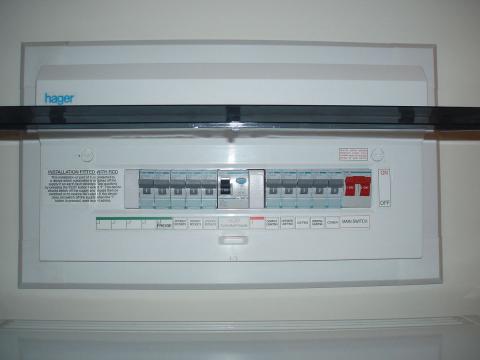
The consumer unit, commonly known as the fuse board, is the brain of the whole installation. So, it’s important to get the correct type for the nature of your electrical installation. To do this effectively requires seeking the assistance of a specialist. However, for the purpose of this blog, I am going to outline the main two types commonly used when installing a new consumer unit, outlining both their separate positives and negatives (no puns intended!)
I’m not going to go into the safety specifications of both models, I have a free help sheet available to educate people on this matter. Rather, I’m going to go into the ‘functionalities’ of both models.
The Dual-R.C.D consumer unit
What is it? – Like the name says, 2x 30mA R.C.D’s each protecting half of the installation’s individual circuits. A good electrician when installing these will set it up in a way in which if one R.C.D activates in the event of a fault, both some lighting and some power will remain on inside the property.
What are the pros- Their cost effective and that’s about it really 😉
What are the cons- a fault on one circuit causes several others to shut down. Also, several small, natural leakage currents in normal operation can cause the R.C.D to operate.
The R.C.B.O consumer unit
What is it? – Separate protective devices each containing overcurrent, short circuit and earth fault protection. Each R.C.B.O has its on 30mA R.C.D protection dedicated to that sole circuit its protecting and not sharing the protection amongst several circuits.
What are the pros- Great for minimising inconvenience in the event of a fault. The R.C.B.O board also has the freedom to add circuits which don’t require R.C.D protection, unlike the typical dual rcd model. In properties where a lot of high-tech electronic equipment is in use with a lot of natural earth leakage current, this is the ideal set up as excess leakage current shared amongst several circuits can likely cause an R.C.D to trip
What are the cons- much more expensive than the dual R.C.D consumer unit
So, what is my take?
I will always pick the R.C.B.O board over the dual R.C.D model. It’s now pushed to be used with the 18th Edition requirements for circuit protection.
However (in my opinion), for the standard sized domestic property, a dual R.C.D consumer unit is a more than adequate choice to protect your installation. I have had a dual R.C.D consumer unit in my place for years and its never posed any nuisance tripping problems.
Most people when I have changed their consumer units have opted for the dual R.C.D bored simply because of cost.
Take note, there are sometimes when the R.C.B.O consumer unit is the only choice. So ALWAYS seek advice of a specialist when you are having your consumer unit upgrade. Its good to share any future plans for the installation before the type of consumer unit is chosen e.g. a future EV charging point

